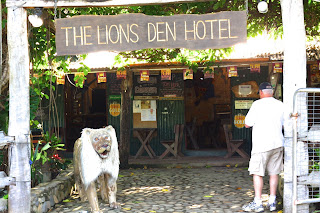I'll do a series of blogs on my Oztours travels this year with a few highlights each trip.
First day was from Cairns to Cooktown via the Bloomfield Track. This controversial track was made in The Daintree Rainforest during 1983/84. Protesters did their best to prevent this track going through. Although the track finished up going through, the publicity highlighted drew the attention of scientific interest as well as that of the rest of the world. This ancient forest is now protected by World Heritage listing which was granted in 1988 as a result of the track and hence the protesters.

Picturesque Woobadda Creek. a great place to stop and stretch our legs and take a few pikkies.
The first night was spent at the Seaview Hotel in Cooktown. We had the luxury of phone reception, electricity, TV and an ensuite all at the same time. This isn't always possible on the Cape as there are very few towns and a limited number of places that have accommodation.
Cape York Peninsular is almost the size of Victoria. Tourism, mining and cattle stations are the main industries. The beauty and remoteness of the pristine landscape and varied ecosystems draws more people to this area each year. I was astounded at the road and accommodation improvements made during my 3 year absence.
After leaving Cooktown the following day, we made our way to Lakefield National Park. Our first stop was Isabella Falls.

An interest feature along the way is the Old Laura Homestead which was run as a cattle station to provide meat to the miners of the Palmer river gold rush in the late 1800s.
A rusted relic of bygone days, waits patiently amid old buildings for its final slow demise.
 |
The pristine Wenlock forms a corridor from east to west and brings with it a number of rare and unusual flora and fauna. It is also home to many rare marine species, some of which are awaiting discovery yet.
Some of the cattle stations supplement their incomes by providing a few tourist comforts for the weary traveller.
Palm Cockatoos are Australia's largest cockatoo. They can only be found on Cape York Peninsular north of Princess Charlotte Bay. They have large red cheek patches and long curved crest feather which distinguish them from their smaller cousins, the Black Cockatoos. Their powerful beaks are able to crack the hard nuts of Pandanus. They are usually found in rainforest and margins adjoining eucalypts, often following the corridors of riverine rainforest.
We were treated to a grand floor (tree) show by the iconic Palm Cockatoos at Bramwell. I took a million photos. Here are 3 of them.


This young brolga which was rehabilitating in a nearby paddock, gave me the opportunity to get a nice closeup. They are usually not so obliging.
While others were enjoying a dip at Fruit Bat Falls, I stood guard protecting them from the numerous carnivorous plants which lurked in the area, waiting for some unsuspecting victim.
 |
| Pitcher Plants |
 |
| Sundews |
A new ferry returns my passengers from their Thursday Island trip to Seisia.
The following day, we go to "the Tip". One more tick off the bucket list!
The following movie goes for 4.17mins and is 52.7mb.
I will try to do a blog on each trip with different features each time. As I will be away much of the time, some of these won't be done till the end of my season, mid Sept. I now have to rush and do some speed research on a new trip for me to the Gulf. I hope my passengers are as excited as I am to be doing this trip.
Tony - the name of the shrub with the yellow flower which grows profusely at Kennedys Lost Camp in Heathlands is the Yellow Tea Tree (Neofabricia myrtifolia)








Fantastic blog Petra. I am inspired!!! I will have to start doing this for my trips too.
ReplyDelete